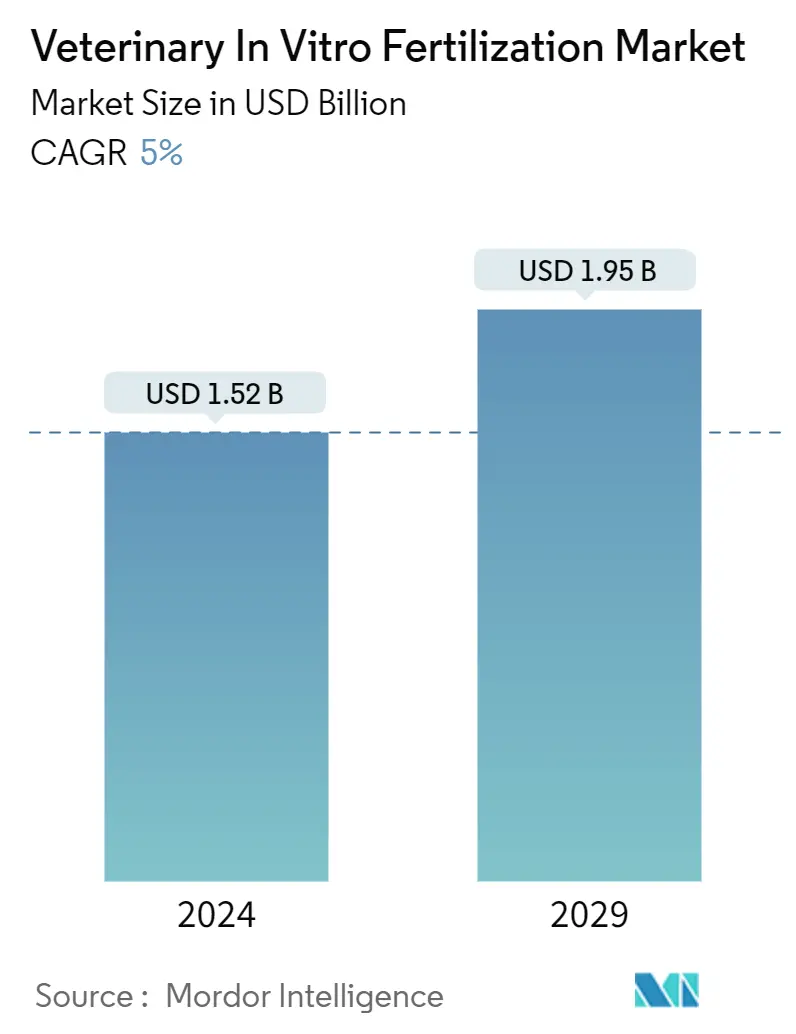Market Size of Veterinary In Vitro Fertilization Industry

| Study Period | 2019-2029 |
| Market Size (2024) | USD 1.52 Billion |
| Market Size (2029) | USD 1.95 Billion |
| CAGR (2024 - 2029) | 5.00 % |
| Fastest Growing Market | Asia Pacific |
| Largest Market | North America |
Major Players
*Disclaimer: Major Players sorted in no particular order |
Veterinary In Vitro Fertilization Market Analysis
The Veterinary In Vitro Fertilization Market size is estimated at USD 1.52 billion in 2024, and is expected to reach USD 1.95 billion by 2029, growing at a CAGR of 5% during the forecast period (2024-2029).
The veterinary in vitro fertilization (IVF) market encountered significant challenges and opportunities during the COVID-19 pandemic. The global supply chain disruption impacted the availability and transportation of essential IVF materials and equipment. This led to operational inefficiencies, increased costs, and delays in project timelines of in-vitro fertilization. Pet owners and livestock breeders, facing financial uncertainties, began perceiving advanced reproductive technologies like IVF as an optional service, potentially leading to a decline in demand for veterinary services and influencing the overall dynamics of the IVF market. However, the pandemic has also underscored the significance of genetic diversity and disease resistance in animal populations. IVF offers a strategic solution to enhance genetic diversity by facilitating controlled breeding practices. Through assisted reproductive technologies like IVF, managing and preserving genetic variability within animal populations becomes possible. This realization drives an increased interest in advanced reproductive technologies such as IVF for safeguarding and enhancing desirable animal genetic traits. In February 2021, Animal Frontiers published that capacity-building programs in animal breeding have had challenges due to restrictions, leading to the rescheduling of most programs during a pandemic.
The post-pandemic era presents opportunities for the veterinary IVF market to rebound and grow. As economies recover, increased investment in research and development may lead to technological advancements and the introduction of more cost-effective solutions. Moreover, the increased awareness regarding the importance of animal health and genetics stimulates renewed interest in advanced reproductive technologies, potentially driving market growth. For instance, in April 2023, Vytelle, LLC. announced USD 20 million in funding for accelerating genetic progress in cattle.
Further, increasing demand for high-quality breeding and advancement in reproductive technology are among the significant factors driving the growth of the veterinary in vitro fertilization market. IVF allows for precision breeding by enabling the selection and propagation of specific genetic characteristics, leading to animals with superior traits such as enhanced disease resistance, improved productivity, and desirable physical attributes. For instance, in December 2021, the Journal of Dairy Science published an article stating that assisted reproductive technologies can contribute to accelerated genetic gain by allowing more offspring to be produced from genetically elite dams.
Moreover, advancements in reproductive technology are also influencing the growth of the in vitro veterinary fertilization market. Technological progress helps reshape and expand the landscape of veterinary-assisted reproduction, presenting breeders and researchers with newfound possibilities and efficiencies. Intracytoplasmic sperm injection (ICSI) proves a precious technique in case of male infertility or challenges associated with conventional insemination in certain species. Furthermore, advancements in imaging technology, such as time-lapse microscopy, facilitate the real-time monitoring of embryo development. For instance, in May 2023, Improve International published that embryo production and transfer technologies allow breeders and vets to increase their herds' genetic improvement rate. In July 2023, MDPI published that over the past 40 years, in vitro embryo production (IVEP) has developed significantly, allowing an increase in the reproductive efficiency of animals with superior genetic merit and the maintenance of the population of endangered species.
Thus, increasing demand for high-quality breeding and advancement in reproductive technology drive the growth of the veterinary in-vitro fertilization market. However, the high cost associated with technology will be expected to restrain the market growth over the forecast period.
Veterinary In Vitro Fertilization Industry Segmentation
Veterinary in-vitro fertilization is a reproductive technique applied in animals to achieve fertilization outside the organism's body. The technique is used to overcome fertility challenges, preserve genetic diversity, and optimize breeding programs, especially when mating is impractical.
The veterinary in-vitro fertilization market is segmented into product types, techniques, end-user, and geography (North America, Europe, Asia-Pacific, Middle East and Africa, and South America). By product type, the market is segmented into instruments, reagents/consumables, and services. By technique, the market is segmented into embryo transfer, artificial insemination (AI), and other techniques. Other techniques include intracytoplasmic sperm injection, zygote intra-fallopian transfer (ZIFT) & gamete intra-fallopian transfer (GIFT). By end user, the market is segmented into veterinary hospitals, fertility clinics, and other end users. Other end-users include research laboratories and cryobanks. By geography, the market is segmented into North America, Europe, Asia-Pacific, the Middle East and Africa, and South America.
For each segment, the market sizing and forecasts have been done on the basis of value (USD).
| By Product Type | |
| Instruments | |
| Reagents/Consumables | |
| Services |
| By Technique | |
| Embryo Transfer | |
| Artificial Insemination (AI) | |
| Other Techniques |
| End-User | |
| Veterinary Hospitals | |
| Fertility Clinics | |
| Other End-Users |
| Geography | ||||||||
| ||||||||
| ||||||||
| ||||||||
| ||||||||
|
Veterinary In Vitro Fertilization Market Size Summary
The veterinary in vitro fertilization market is poised for growth, driven by increasing demand for advanced breeding practices and genetic improvement. The market, which faced challenges during the COVID-19 pandemic due to supply chain disruptions and financial uncertainties among pet owners and livestock breeders, is expected to rebound as economies recover. The pandemic highlighted the importance of genetic diversity and disease resistance, fostering renewed interest in IVF as a strategic solution for enhancing animal genetic traits. Technological advancements in reproductive technologies, such as intracytoplasmic sperm injection and time-lapse microscopy, are reshaping the landscape of veterinary-assisted reproduction, offering new possibilities for precision breeding and improved reproductive efficiency.
The North American region is a significant contributor to the market's growth, driven by the economic importance of leveraging IVF technologies in livestock breeding and a strong culture of responsible pet ownership. The presence of leading companies and research institutions in the region fosters innovation and collaboration, further propelling market expansion. The ongoing development of laboratory equipment and the increasing demand for automation and robotics in veterinary IVF laboratories are also key factors driving the market. Despite the high costs associated with these technologies, the market remains semi-consolidated, with a few international and local players holding moderate market shares, actively contributing to the evolution of veterinary IVF technologies.
Veterinary In Vitro Fertilization Market Size - Table of Contents
-
1. MARKET DYNAMICS
-
1.1 Market Overview
-
1.2 Market Drivers
-
1.2.1 Increasing Demand for High - Quality Breeding
-
1.2.2 Advancement in Reproductive Technology
-
-
1.3 Market Restraints
-
1.3.1 High costs associated with the Technology
-
-
1.4 Porter's Five Forces Analysis
-
1.4.1 Bargaining Power of Suppliers
-
1.4.2 Bargaining Power of Buyers/Consumers
-
1.4.3 Threat of New Entrants
-
1.4.4 Threat of Substitute Products
-
1.4.5 Intensity of Competitive Rivalry
-
-
-
2. MARKET SEGMENTATION (Market Size by Value - USD)
-
2.1 By Product Type
-
2.1.1 Instruments
-
2.1.2 Reagents/Consumables
-
2.1.3 Services
-
-
2.2 By Technique
-
2.2.1 Embryo Transfer
-
2.2.2 Artificial Insemination (AI)
-
2.2.3 Other Techniques
-
-
2.3 End-User
-
2.3.1 Veterinary Hospitals
-
2.3.2 Fertility Clinics
-
2.3.3 Other End-Users
-
-
2.4 Geography
-
2.4.1 North America
-
2.4.1.1 United States
-
2.4.1.2 Canada
-
2.4.1.3 Mexico
-
-
2.4.2 Europe
-
2.4.2.1 Germany
-
2.4.2.2 United Kingdom
-
2.4.2.3 France
-
2.4.2.4 Italy
-
2.4.2.5 Spain
-
2.4.2.6 Rest of Europe
-
-
2.4.3 Asia-Pacific
-
2.4.3.1 China
-
2.4.3.2 Japan
-
2.4.3.3 India
-
2.4.3.4 Australia
-
2.4.3.5 South Korea
-
2.4.3.6 Rest of Asia-Pacific
-
-
2.4.4 Middle East and Africa
-
2.4.4.1 GCC
-
2.4.4.2 South Africa
-
2.4.4.3 Rest of Middle East and Africa
-
-
2.4.5 South America
-
2.4.5.1 Brazil
-
2.4.5.2 Argentina
-
2.4.5.3 Rest of South America
-
-
-
Veterinary In Vitro Fertilization Market Size FAQs
How big is the Veterinary In Vitro Fertilization Market?
The Veterinary In Vitro Fertilization Market size is expected to reach USD 1.52 billion in 2024 and grow at a CAGR of 5% to reach USD 1.95 billion by 2029.
What is the current Veterinary In Vitro Fertilization Market size?
In 2024, the Veterinary In Vitro Fertilization Market size is expected to reach USD 1.52 billion.

